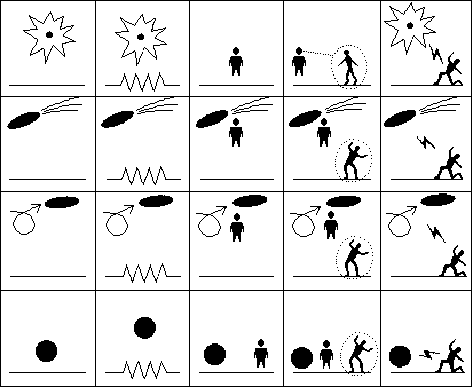| 1 | 2 | 3 | 4 | 5 | |
|
AN |
 |
||||
|
FB |
|||||
|
MA |
|||||
|
CE |
|||||
| Sighting | Physical Effects |
Living Entities |
Reality Transfor- mation |
Lasting Injury |
|
Sighting Categorization
Most ufologists devise some means to categorize their collection of sighting reports. J. Allen Hynek published a simple system in 1972 for quantifying strangeness. He defined these categories:
| Class | Category | Characteristics |
| Distant Sightings | Nocturnal Lights; NL | Only a light is seen, although it may behave anomalously. |
| Daylight Discs; DD | Typically an oval or disc shape. | |
| Radar-Visual; RV | Simultaneous, direct observation by radar and human eye. | |
| Close Encounters | First Kind; CE1 | Close range, details visible, but no interaction with environment. |
| Second Kind; CE2 | Physical effects -- ground marks, tree branches broken, animals frightened, vehicle interference, headlights, etc. | |
| Third Kind; CE3 | Alien occupants observed in and/or around the UFO. |
Later researchers added a CE4; close encounter of the fourth kind: abduction.
Jacques Vallée, a close associate of Hynek, published a more detailed system in 1990 to better describe the growing range of reported phenomena. But note that Vallée, who questioned that people are actually abducted, provided no explicit symbol for abduction:
| 1 | 2 | 3 | 4 | 5 | |
|
AN |
 |
||||
|
FB |
|||||
|
MA |
|||||
|
CE |
|||||
| Sighting | Physical Effects |
Living Entities |
Reality Transfor- mation |
Lasting Injury |
|
Some researchers, e.g. John E. Mack, postulate that reality transformation phenomena occur during the sighting while the witness experiences altered states of consciousness: mental states subjectively recognized as different in psychological functioning from the normal, alert state.
Using Vallée's system, what three-character code would you give to the sighting of an object which circled your house at treetop height, with an alien figure visible in the dome of the object? Answer